A) a diagram that shows the different strategies that each player can follow in a game and the viability of those strategies for each player.
B) a diagram that shows the different strategies that each player can follow in a game and the probability that each player will choose each strategy.
C) a diagram that shows the different strategies that each player can follow in a game and the order in which those strategies get chosen.
D) a diagram that shows the optimal strategy for each player.
Correct Answer

verified
Correct Answer
verified
Multiple Choice
In the following games, all payoffs are listed with the row player's payoffs first and the column player's payoffs second. 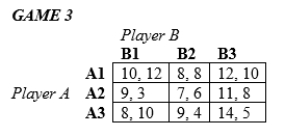 -In Game 3 above,
-In Game 3 above,
A) Player A has a dominant strategy.
B) Player B has a dominant strategy.
C) Both players have a dominant strategy.
D) Neither player has a dominant strategy.
Correct Answer

verified
Correct Answer
verified
Multiple Choice
In the following games, all payoffs are listed with the row player's payoffs first and the column player's payoffs second (36-40) . 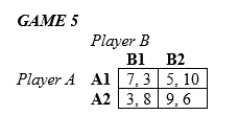 -In Game 5 above, if the players move sequentially with Player B choosing first, the Nash equilibrium will be
-In Game 5 above, if the players move sequentially with Player B choosing first, the Nash equilibrium will be
A) Player A choosing A1 and Player B choosing B1.
B) Player A choosing A1 and Player B choosing B2.
C) Player A choosing A2 and Player B choosing B1.
D) Player A choosing A2 and Player B choosing B2.
Correct Answer

verified
Correct Answer
verified
Multiple Choice
A strategy in which you do to your opponent in this period what your opponent did to you in the last period is a:
A) live-and-let-live strategy
B) shoot-to-kill strategy.
C) grim trigger strategy.
D) tit-for-tat strategy.
Correct Answer

verified
Correct Answer
verified
Multiple Choice
In the following games, all payoffs are listed with the row player's payoffs first and the column player's payoffs second. 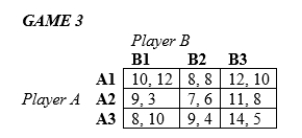 -In Game 3 above,
-In Game 3 above,
A) A1 is a dominated strategy for Player A
B) A2 is a dominated strategy for Player A
C) A3 is a dominated strategy for Player A
D) Player A has no dominated strategies.
Correct Answer

verified
Correct Answer
verified
Multiple Choice
Under a mixed strategy,
A) players move sequentially.
B) a player chooses among two or more pure strategies according to pre-specified probabilities.
C) the players may never reach a Nash equilibrium.
D) players obtain lower payoffs than in a pure strategy equilibrium.
Correct Answer

verified
Correct Answer
verified
Multiple Choice
The likelihood of a cooperative outcome in a repeated prisoners' dilemma type game increases when:
A) interactions between the players are frequent.
B) the players are impatient.
C) cheating is not detectable.
D) there is a large gain from cheating.
Correct Answer

verified
Correct Answer
verified
Multiple Choice
In the following games, all payoffs are listed with the row player's payoffs first and the column player's payoffs second (36-40) . 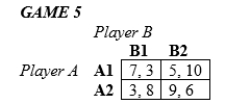 -In Game 5 above, in the Nash equilibrium in mixed strategies
-In Game 5 above, in the Nash equilibrium in mixed strategies
A) player A chooses A1 with a 2/9 probability.
B) player A chooses A1 with a 3/9 probability.
C) player A chooses A1 with a 4/9 probability.
D) player A chooses A1 with a 5/9 probability.
Correct Answer

verified
Correct Answer
verified
Multiple Choice
In the following games, all payoffs are listed with the row player's payoffs first and the column player's payoffs second (36-40) . 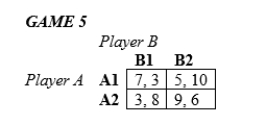 -In Game 5 above,
-In Game 5 above,
A) Player A has a dominant strategy.
B) Player B has a dominant strategy.
C) Both players have dominant strategies.
D) Neither player has a dominant strategy.
Correct Answer

verified
Correct Answer
verified
Showing 61 - 69 of 69
Related Exams